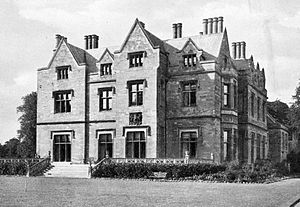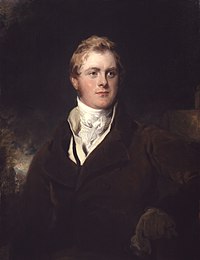
Stanmore is part of the London Borough of Harrow in Greater London. It is centred 11 miles (18 km) northwest of Charing Cross, lies on the outskirts of the London urban area and includes Stanmore Hill, one of the highest points of London, at 152 metres (499 ft) high. The district, which developed from the ancient Middlesex parishes of Great and Little Stanmore, lies immediately west of Roman Watling Street and forms the eastern part of the modern London Borough of Harrow.

Sir George Gilbert Scott, largely known as Sir Gilbert Scott, was a prolific English Gothic Revival architect, chiefly associated with the design, building and renovation of churches and cathedrals, although he started his career as a leading designer of workhouses. Over 800 buildings were designed or altered by him.

Frederick John Robinson, 1st Earl of Ripon,, styled The Honourable F. J. Robinson until 1827 and known between 1827 and 1833 as The Viscount Goderich, the name by which he is best known to history, was a British politician who served as Prime Minister of the United Kingdom from 1827 to 1828.

George Frederick Samuel Robinson, 1st Marquess of Ripon,, styled Viscount Goderich from 1833 to 1859 and known as the Earl of Ripon in 1859 and as the Earl de Grey and Ripon from 1859 to 1871, was a British politician and Viceroy and Governor General of India who served in every Liberal cabinet between 1861 and 1908.

Thomas Philip de Grey, 2nd Earl de Grey, 3rd Baron Grantham, 6th Baron Lucas, KG, PC, FRS, styled as The Hon. Thomas Robinson until 1786 and as Lord Grantham from 1786 to 1833, of Wrest Park in the parish of Silsoe, Bedfordshire, was a British Tory statesman. He changed his surname to Weddell in 1803 and to de Grey in 1833.

Earl de Grey, of Wrest in the County of Bedford, was a title in the Peerage of the United Kingdom.

Marquess of Ripon, in the County of York, was a title in the Peerage of the United Kingdom. It was created in 1871 for the Liberal politician George Robinson, 2nd Earl of Ripon.

RAF Bentley Priory was a non-flying Royal Air Force station near Stanmore in the London Borough of Harrow. It was the headquarters of Fighter Command in the Battle of Britain and throughout the Second World War. The Royal Air Force station closed its operations on 30 May 2008, with all units relocating to new accommodation at RAF Northolt, a few miles away.
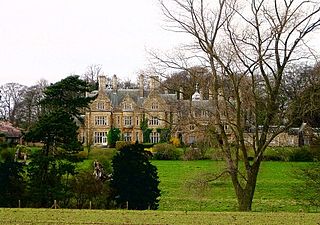
Branston Hall is a country house in the village of Branston, Lincolnshire, England. The hall, a Grade II listed building, is set in 88 acres of wooded parkland and lakes.
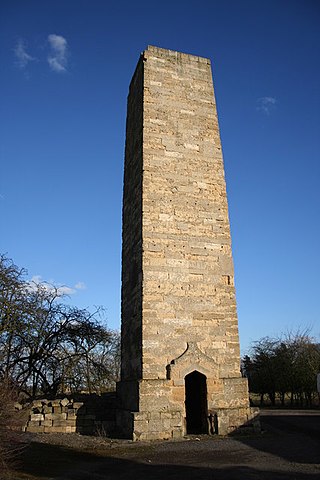
Dunston Pillar is a Grade II listed stone tower in Lincolnshire, England and a former 'land lighthouse'. It stands beside the A15 road approximately 6 miles (10 km) south of Lincoln near the junction of the B1178, in the parish of Dunston, north of Sleaford. Closed to the public. On private land.

Studley Royal Park including the ruins of Fountains Abbey is a designated World Heritage Site in North Yorkshire, England. The site, which has an area of 800 acres (323 ha), features an 18th-century landscaped garden, some of the largest Cistercian abbey ruins in Europe, ruins of a Jacobean mansion and a Victorian church designed by William Burges.

Nocton is a village and civil parish in the North Kesteven district of Lincolnshire, England. It is situated on the B1202 road, 7 miles (11 km) south-east from Lincoln city centre. The population of the civil parish at the 2011 census was 819. To the east of the village is Nocton Fen with its small settlement of Wasps Nest. To the west of the village, situated at the junction of Wellhead Lane and the B1188 road, is Nocton Top Cottages consisting of eight further dwellings. At the south of the village are the remains of Nocton Hall, and 1 mile (2 km) to the east the earthwork remains of Nocton Park Priory.
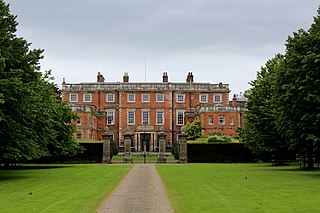
Newby Hall is a country house beside the River Ure in the parish of Skelton-on-Ure in North Yorkshire, England. It is 3 miles (4.8 km) south-east of Ripon and 6 miles (9.7 km) south of Topcliffe Castle, by which the manor of Newby was originally held. A Grade I listed building, the hall contains a collection of furniture and paintings and is surrounded by extensive gardens. Newby Hall is open to the public.

Bentley Priory is an eighteenth to nineteenth century stately home and deer park in Stanmore on the northern edge of the Greater London area in the London Borough of Harrow.

Edward Montagu (1692–1776) was a wealthy English landowner, who owned numerous coal mines and had several rents and estates in Northumberland. The son of Hon. Charles Montagu, MP, by Sarah Rogers, and the grandson of Edward Montagu, 1st Earl of Sandwich, he was educated at Eton College, Clare College, Cambridge and Lincoln's Inn.

Milton Hall near Peterborough, is the largest private house in Cambridgeshire, England. As part of the Soke of Peterborough, it was formerly in Northamptonshire. It dates from 1594, being the historical home of the Fitzwilliam family, and is situated in an extensive park in which some original oak trees from an earlier Tudor deer park survive. The house is a Grade I listed building; the garden is Grade II*.
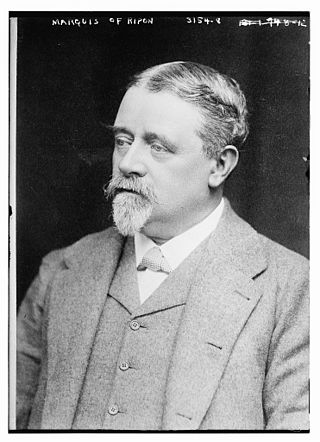
Frederick Oliver Robinson, 2nd Marquess of Ripon,, styled Viscount Goderich between 1859 and 1871 and Earl de Grey between 1871 and 1909, was a British courtier and Liberal politician.

Nocton Park Priory was an Augustinian priory in Nocton, Lincolnshire, England.

Christopher Turnor MP, JP, DL, was an English Conservative Party politician who sat in the House of Commons from 1841 to 1847, and a promoter of Lincolnshire architecture.

Sarah Albinia Louisa Robinson, Countess of Ripon was the wife of F. J. Robinson, 1st Viscount Goderich, who was Prime Minister of the United Kingdom between 1827 and 1828.



